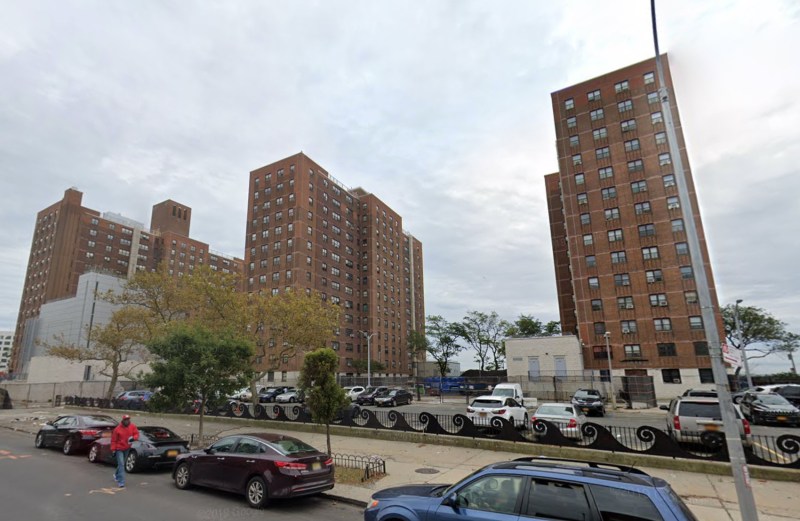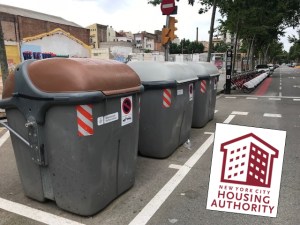NYCHA Trash Containerization Set to Launch in Coney Island

The city’s plan to test containerized residential garbage collection at public housing developments will roll out in Brooklyn’s Coney Island section, likely next year, according to the New York City Housing Authority.
Under a plan to test a garbage collection method that has long been routine in other cities like Barcelona or Paris, new NYCHA trucks will directly lift the curbside boxes outside developments in the coastal neighborhood, getting rid of the heaps of black bags that regularly pile up on the sidewalk.
About two-thirds of NYCHA’s garbage is already stored in large sealed containers at so-called waste yards inside the public housing complexes, and the DSNY drives its trucks in to empty them several times a week, according to the Housing Authority’s request for proposals issued back in September. The RFP says that the pilot program will consist of up to four NYCHA trucks with hoisting mechanisms, plus more than 70 containers.
NYCHA staff still has to haul the rubbish from designated areas where residents leave it to the central storage areas, and tenants don’t have access to those big boxes. Authority staff set out the remaining third of residential rubbish on the curb — approximately 33.5 tons of material a day citywide — because some developments lack the space to keep large containers on their campuses.
The Department of Sanitation collects recyclables from the curb at all NYCHA developments.
Curbside containers — into which residents can put their own garbage and recycling and which trucks would hoist and empty — would get rid of the mountains of black bags blocking the sidewalk and significantly reduce the time staff spends moving around garbage, according to the public housing agency.
Officials picked a vendor earlier this spring and plan to award a contract around June, according to agency spokesman Michael Horgan, and they expect to launch the project about six to nine months afterward, which would put the start date between the end of this year and mid-2024.
NYCHA officials have not yet publicly released which vendor they chose or specify which of the agency’s housing developments in Coney Island will get the containerized collection. Horgan noted the locations are still tentative and subject to change.
The housing authority is leading the pilot, but Sanitation officials are also advising the agency.
The residents association president at Coney Island Houses, a complex of five 14-story tower blocks on Surf Avenue, said curbside containers would be a welcome improvement.
“It’s a great idea, why not try it. You don’t know unless you try it,” said Lauretta Brumfield. “I hope I’ll be the lucky one to get it.”
Currently, building staff leave garbage on the curb outside the development between W. 29th and W. 32nd streets, taking up scarce sidewalk space next to two busy bus stops that local kids, seniors and people commuting to work rely on, Brumfield said.
“That’s walking space, so if they had something stable there you would have more walking space as well,” the tenant leader said. “Who wants to stand near where rats are running all around?”
The pilot is part of the authority’s 2019 Waste Management Plan agreement with the U.S. Department of Housing and Urban Development to clean up its complexes and make its buildings and grounds by 2025.
If the test is successful, containerization could expand across NYCHA’s sprawling portfolio of roughly 162,143 apartments, though that would require coordination with DSNY.
Other cities have long containerized their garbage, but putting garbage in its place has eluded the Big Apple. City officials have started several tests and studies to make it happen here.

Experts were excited for the move by the city’s largest landlord, which could become a model.
“It will be great for the city, I mean, ‘Go NYCHA!'” said Clare Miflin, an architect and the founder of Center for Zero Waste Design. “If these bags can go straight into the containers in the parking lane, it’ll be much better for residents. It’ll keep the developments cleaner and clearer, it’ll be easier for staff — I just see it as a positive.”
Miflin’s organization showed how containerized garbage collection could work on the Vanderbilt Avenue Open Street a report last month, detailing how the six-block stretch with its various building types could be a model for boxing up garbage across large swaths of the city.
DSNY is also working on its own citywide $4 million containerization study with help from consultants at McKinsey.
Sanitation has been testing outdoor containers for residential trash on one block in Hells Kitchen since late last year. The initiative successfully cleared the sidewalk of mountains of black bags, but the boxes are only accessible to building supers and New York’s Strongest, who still have to haul the rubbish into their trucks by hand. DSNY Commissioner Jessica Tisch called that approach “not scalable.”
